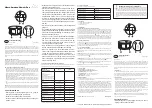
InteliLite4 AMF20 Global Guide
114
Electric state machine
MainsOper
Mains is present and all its values are within limits.
Example:
MCB is closed, GCB is opened
MainsFlt
Mains fails
IslOper
Island operation
Example:
MCB is opened, GCB is closed
MainsRet
Mains recover
BrksOff
GCB, MCB opened
5.5.10 Additional running engine indications
It is helpful to have information other than speed (RPM), whether the engine is rotating or not, especially if
RPM is measured from the generator frequency instead of magnetic pickup. The generator frequency
measurement can be unreliable at very low speeds and/or may have a delayed reaction to sudden and big
changes (i.e. in the moment that the engine has just started…).
The following conditions are evaluated as additional running engine indication:
Voltage on the D+ input is higher than the
of battery voltage. Connect this input
to the D+ (L) terminal of the charging alternator and enable the D+ function by the setpoint
. If D+ terminal is not available, leave the input unconnected and disable the function.
The pickup is not used and frequency is not detected on the pickup input. Connect the pickup input to the
W terminal of the charging alternator if you do not use pickup and the W terminal is available. If not, leave
the input unconnected.
Oil pressure >
Starting Oil Pressure (page 228)
setpoint. The oil pressure is evaluated from the analog
input or from the ECU if an ECU is configured.
Binary input
is in logical 0.
At least one phase of generator voltage is >25 % of nominal voltage.
These signals are used during start for powering down the starter motor even if no RPM is measured. These
signals are used during stop in order to evaluate if the engine has really stopped.
5.5.11 History log
The history log is an area in the controller’s non-volatile memory that records "snapshots" of the system at
moments when important events occur. The history log is important especially for diagnostics of failures and
problems. When the history file is full, the oldest records are removed.
Each record has the same structure and contains:
The event which caused the record (e.g. "Overspeed alarm" or "GCB closed")
The date and time when it was recorded
All important data values such as RPM, kW, voltages, etc. from the moment that the event occurred.
















































